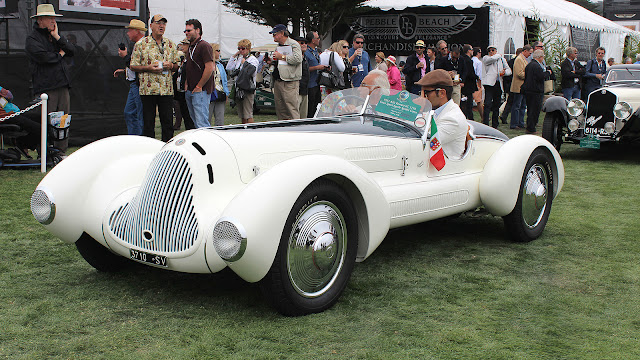The 1931 Alfa Romeo 6C 1750 Gran Sport Aprile Roadster that made its Concours debut at Pebble Beach last month will be a featured automobile in the special classes of Pre- and Post-War Sports and Grand Touring Cars at the fifth annual Louisville Concours d’Elegance, held October 5-7, 2012 at historic Churchill Downs in Kentucky.The Aprile Roadster was originally constructed as a supercharged Gran Sport chassis in 1931 bodied by Zagato as a racing car. The car was purchased with extensive damage in 1938 by Giuseppe Aprile, a coachbuilder in Savona who intended to rebody the Alfa in a style that would showcase the abilities of his Carrosserie. Aprile commissioned Count Revelli de Beaumont to designed the body.
Gran Sport Aprile
Perhaps not as well known as later models, the Alfa Romeo 6C 1750 is one of the quintessential Alfa Romeos of its era. First introduced as a replacement for the 6C 1500 in 1929, the 6C 1750 evolved from a relatively simple road car to a very sophisticated racing machine in the five years it was produced. One of the key elements in the progress was designer Vittorio Jano, lured to Alfa Romeo from his former employer Fiat by Enzo Ferrari.Jano's first design for Alfa Romeo was the 6C 1500, which featured a small six cylinder engine with a single overhead camshaft. Competition versions of this relatively small Alfa Romeo were quite successful, with a highlighted victory in the 1928 running of the Mille Miglia. At the 1929 Rome Motorshow, the 6C 1750 was introduced. Technically it was almost identical to the 6C 1500, with the enlarged engine as the biggest difference.First and foremost the 6C 1750 was intended to carry larger and heavier fixed head bodies. The first model available, the Turismo, was equipped with a 3.1 metre wheelbase. Soon after a shorter wheelbase version, dubbed Sport, was launched. More importantly it was fitted with a double overhead camshaft engine, which would form the base for a series of very successful competition engines. The most powerful version was the Super Sport, which was fitted with a 95 bhp supercharged engine.
Production of the Sport and Super Sport lasted for only two years. The replacements were the Naturally Aspirated Gran Turismo and supercharged Gran Sport. With a wheelbase of just over 2.7 metres, the Gran Sport was not only the most powerful, but also the shortest of the series. It is this model that is best known of all 6C 1750s produced. The final evolution was a further modified Gran Sport, produced in 1933. It was equipped with various chassis modifications compared to earlier models.As was common practice in the day, the cars were delivered as rolling chassis for the coach-builders to body. Most of the 6C 1750s were bodied by Italian coach builders, with Zagato and Touring being responsible for the bulk of these. Other notable coach builders were Castagna and Stabilimenti Farina. Zagato's bodies were mainly chosen for the competition cars, because of their light weight.In 1933 the Gran Sport model was replaced by the 8C 2300, which shared the Gran Sport's basic design elements. The Turismo was replaced by a series of six cylinder cars of which the production would last until the outbreak of the Second World War. All of Alfa Romeo's successful competition models of the 1930s built on the lessons learned in the development of the 6C 1750. Jano's double overhead camshaft design would remain unchanged and proved a winning formula in both Grand Prix and Sports car racing.
Chassis: 10814331
Constructed in 1931, this 6C 1750 Gran Sport was clothed by Zagato with the familiar roadster bodywork for its first, Turin-based owner. In 1938, the six cylinder Alfa Romeo was acquired by Giuseppe Aprile from Savona. By this time the Zagato body had been badly damaged but Aprile, fortunately, also owned his own 'Carrozzeria'. Instead of repairing the damaged coachwork, he decided to fit a brand new and more modern body.Aprile called in the services of Count Revelli de Beaumont to pen the new lines. The noted designer created a stunningly aerodynamic shape that bore some resemblance to the contemporary Alfa Romeo Grand Prix and sports racers. Soon after the work was completed, Aprile sold the car to a local enthusiast. He carefully hid the car during the War and owned it until 1956. The fourth owner cherished the unique machine and held on to it for over five decades during which it was only very rarely seen.An Italian collector of one-off coach-built machinery, the current custodian eventually acquired the car in 2008. He has since had the car meticulously restored before bringing it to the 2012 Pebble Beach Concours d'Elegance; the Alfa Romeo's first ever journey abroad. The Aprile Spider Corsa placed second in class, beaten only by another one-off 6C 1750 Gran Sport.
Source: Ultimatecarpage (Wouter Melissen)












.jpg)








0 comments:
Post a Comment